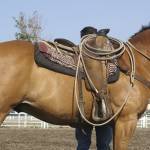Protect Your Horse from Back Pain

Back pain in horses can be subtle or obvious; can manifest as shifting lameness or just a generally sour attitude; and is sometimes tricky to diagnose and hard to relieve. Savvy owners put their efforts into preventing back pain in their horses rather than trying to eliminate it once the discomfort sets in. Here are a few things to think about:
Be sure your saddle fits well and your pads are in good condition. Many excellent articles address how to check your saddle for the best fit. If you still have doubts, ask an instructor or more experienced rider to help you. Keep saddle pads clean, be sure they lie flat under the saddle without pushing down on the withers, and replace pads that become thin or worn.
- Maintain a regular schedule of hoof trimming and shoe resetting (about every 4 to 6 weeks for most horses). Slight changes in the length or angle of the hooves can make a horse move differently, possibly stressing his back and legs.
- Be sure your horse is in condition to do the work asked of him. Follow an exercise program that begins with short, easy workouts and progresses gradually to longer, more intense exercise sessions. Once your horse achieves the desired level of physical conditioning, work him enough to maintain that level. Suddenly asking an out-of-shape horse for hours of work—even slow trail riding—is almost guaranteed to produce a sore back.
- For young, older, excessively fat, or out-of-condition horses, go slow and easy with exercise. These horses need to move, but they are more easily injured than fit horses at the peak of their athletic careers.
- Pay attention to early signs of back pain, and give your horse a few days off before resuming regular work. A short break might be all that is necessary for a minor injury to resolve.
- In ridden horses, the rider’s position and ability may also affect the horse’s back. Consider having your riding evaluated by a qualified professional trainer. An instructor may spot faults you aren’t aware of, and simply correcting your position might make it much easier for your horse to balance your weight and ward off back injuries.
- Ask a veterinarian to check your horse if back pain seems to be at all severe or lasts more than a few days. Most serious back pain won’t go away by itself unless you change what you’re doing (saddle, exercise program, riding style) in some way and also get veterinary assistance.
- Some horses that exhibit back soreness may be sore elsewhere (such as in hocks or stifles) and moving abnormally to protecting the other area. This unnatural carriage may result in back soreness. It is important to determine if the horse is experiencing primary back soreness or whether it is secondary to joint discomfort elsewhere.








